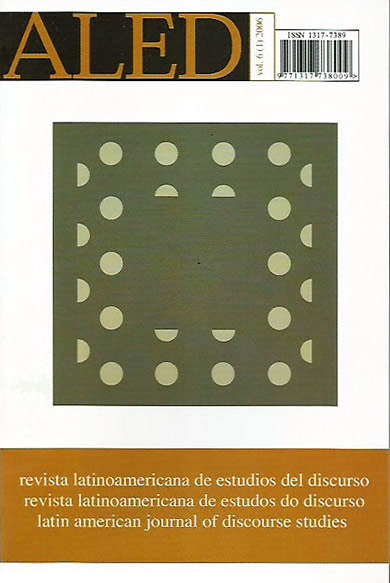Originalidad versus claridad en el discurso académico
la comprensión del evidencial reformulativo ‘en todo caso’
Keywords:
academic writing. evidentiality. non-paraphrastic marker. polyphony.Abstract
The aim of the present paper is to analyze, from a microdiscursive approach, the Spanish non-paraphrastic marker en todo caso as an evidential strategy of academic writing in Social Sciences. The hypothesis is that this marker not only serves as a quotative evidential with a function of distancing language which, according to the case, hedges the assertive, refutative or argumentative force of discourse (García Negroni, 2002), but it is also used as a strategy by which the writer adds complexity to his discourse as an attempt to turn it ”“after his colleagues’ validation”“ into an original scientific fact. In order to prove my hypothesis, I apply a sample test to analyze the effect of en todo caso on unskilled readers’ comprehension processes. As a conclusion, I suggest that the complexity in the comprehension process of this marker is closely connected with the recognizing of reformulation, negation and polyphonic-argumentative procedures triggered by its occurrence in the discourse; but above all, because it is used as a strategy of discursive complexity. Thus, it responds to the academic writer’s need to place himself/herself in a space of conceptual originality, weakening the limits between his discourse and others’ - a delicate balance, indeed, between repetition and originality
Downloads
References
AIKHENVALD, A. Y. (2004) Evidentiality. United States: Oxford University Press.
ANSCOMBRE, J. C. (1998) “Pero/sin embargo en la contra-argumentación directa: razonamiento, genericidad y léxico”, Signo & Seña. Revista del Instituto de Lingüística, 9: 200-224.
ANSCOMBRE J. C. & O. Ducrot (1977) ‘Deux mais en français’, Lingua,: 23-40.
CHAFE, W. (1986) “Evidentiality in English Conversation and Academic Writing”, en W. Chafe & J. Nichols (eds.). Evidentiality: the linguistic coding of epistemology, pp. 261-272. New Jersey, Abblex Publishing Corporation.
DEMONTE, V. y Soriano, O. F. (2004) “Features in COMP and syntactic variation: the case of ‘(de)queísmo’ in Spanish”, Lingua, 115(8): 1063-1082.
DUCROT, O. (2000), “La elección de las descripciones en semánticaargumentativa léxica”, Discurso y Sociedad , 2(4): 33-44.
ESTRADA, A. (2004) “Acercamiento microdiscursivo al estudio de la modalidadepistémica en el discurso académico”, Actas del Congreso Internacional Debatesactuales. Las teorías críticas de la Literatura y la Lingüística. Universidad deBuenos Aires, FFyL, Departamento de Letras, 2005, CD Rom, ISBN 950-29-0897-X.
GARCÃA NEGRONI, M. M. (2002) “En todo caso: atenuação, polidez eevidencialidade”, Letras de Hoje, 37(3): 93-121.
GARCÃA NEGRONI, M.M. (1989) “La negación metalingüística, argumentacióny escalaridad”, Signo y Seña, 9: 227-252.
GARCÃA NEGRONI, M.M. (2005) “Argumentación y polifonía en el discursocientífico-académico. A propósito de ciertos conectores especializados en latransgresión argumentativa”, Rasal, 1: 11-24.
GÜLICH, E. y KOTSCHI, TH. (1983) “Les marqueurs de la reformulationparaphrastique”, Cahiers de Linguistique Francaise 5: 305-351.
HYLAND, K. (1998) Hedging in scientific research articles, Amsterdam/Philadelfia:John Benjamins Publishing Co.
HYLAND, K. (2000) Disciplinary Discourses. Social Interactions in AcademicWriting. England: Pearson Education Limited.
KOVACCI, O. (1994) “Las construcciones con sino y no... pero, y los camposléxicos”, en O. Kovacci (Comp.), Estudios de gramática española, pp. 191-203. Buenos Aires: Edicial.
LEONETTI, M. y ESCANDELL VIDAL, V. (2003) “On the quotative readingsof Spanish Imperfecto”, Cuadernos de Lingüística X:135-154.
MOESCHLER, J. (1999) “Contraintes structurelles et contraintes d’enchainementdans la description des connecteurs concessifs en conversation”, Cahiers delinguistique française, Genève, 5: 131-152.
MONTOLÃO, E. (coord.), M. Garachana y M. Santiago (2000), Manual deescritura académica. Barcelona, Ariel.
MUSHIN, I. (2001) Evidentiality and Epistemological Stance. Narrative Retelling,Amsterdam/Philadelphia: John Benjamins Publishing Company.
PÉREZ SERRANO, M. G. (1994) Investigación cualitativa. Retos e inconvenientes.Madrid: La Muralla (2 volúmenes).
PLANTIN, CH. (1978) “Deux mais”, Semantikos. Homo Monini Lupus, vol. 2(2-3) : 89-93. París: The Semantikos Association.
PORTOLÉS, J. (1998) “El concepto de suficiencia argumentativa”, Signo & Seña,9: 199-224.
ROSSARI, C. (1990) “Projet pour une typlogie des opérations de reformulation”,Cahiers de Linguistique Francaise 11: 345-359.
SWALES, J. (1990) Genre analysis: English in Academic and Research Settings,Cambridge: Cambridge University Press.
VAN DE VOORDE, K. (1992) ´ ̈De deux à trois mais: essai de vérification desapproches d’Anscombre et Ducrot et de Blumenthal”, Traveaux deLinguistique, 24 : 57-80.
Downloads
Published
How to Cite
Issue
Section
License

This work is licensed under a Creative Commons Attribution-NonCommercial-NoDerivatives 4.0 International License.
The authors retain the copyright and guarantee RALED the right to be the first publication of the work as well as a Creative Commons Attribution License that allows others to share the work with recognition of authorship and the initial publication in this journal.




